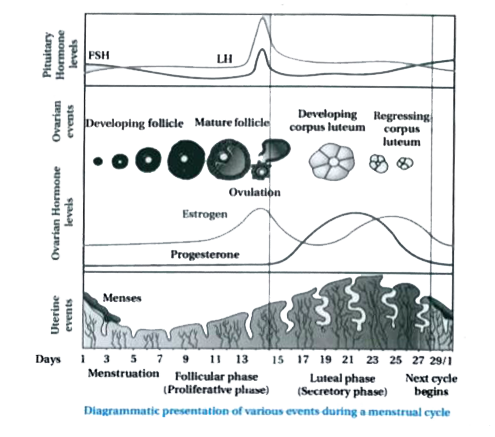What is called menstrual cycle? Describe its phases?
Text Solution
The reproductive cycle in the female primates (eg. Monkeys, apes and human beings) is called menstrual cycle.
The first menstruation begins at puberty and is called menarche.
In human females, menstruation is repeated at an average interval of about 28/29days and the cyle of events starting from one menstruation till the next one is called the menstrual cycle.
One ovum is released (ovulation) during the middle of each menstrual cycle.
Menstrual cycle or events of uterus cycle are cycle changes occuring in endometrium.
Female sex hormones produced in blood are estrogen and projesterone, are responsible in their layer.
The events of this cycle can be divided in 28 days in following 3 phases.
Menstrual phase (Day 1-5) : the menstrual flow results due to breakdown of endrometrial lining of the uterus and its blood vessels which forms liquid that comes out through vagina. It lasts for 3-5 days.
50 ml to 150 ml blood is wasted during this time. This phase is also called menstrual phase. Lack of menstruation may be indicative of pregnancy.
However it may also be caused due to some other underlying causes like stress, poor health etc.
Follicular phase (day 6-14) : During this phase the primary follciles in the ovary grow to become a fully mature Graafian follicle and simultaneously the endometrium of uterus regenerates through proliferation.
These changes in the ovary and the uterus are induced by changes in the level of pituitary and ovarian hormones.
The secretion of gonadotropins (LH and FSH) increases gradually during the follicular phase and stimulates follicular development as well as secretionof estrogens by the growing follicles.
In the middle of cycle (about 14th day) both LH and FSH attain a peak level.
Rapid secretion of LH leading to its maximum level during the mid cycle called LH surge induces rupture of Graafian follicle and there by the release of ovum (ovulation).

Luteal phase (Day 15 to 28) ovulation : The ovulation (ovulatory phase) is followed by the luteal phase during which the remaining parts of the Graafian follicle transform as the corpus luteum.
The corpus luteum secretes large amounts of progesterone which is essential for maintenance of the endometrium.
Such a Endometrium, layer of uterus is necessary for the implantation of the fertilised ovum and other events of pregnancy.
During pregnancy of events of menstrual cycle stop and there is no menstruation.
In the absence of fertilisation, the corpus luteum degenerates. Thus causes disintegration of endometrium leading to menstruation marking a new cycle.
In human beings, menstrual cycles ceases around 50 years of age that is termed as menopause.
Cyclic menstruation is an indicator of normal reproductive phase and extends between menarche and menopause.
|
Topper's Solved these Questions
- HUMAN REPRODUCTIONBOOK - KUMAR PRAKASHANCHAPTER - HUMAN REPRODUCTIONEXERCISE - SECTION-B (DIFFERENCE / SCIENTIFIC REASONS)
6 Videos
- HUMAN REPRODUCTIONBOOK - KUMAR PRAKASHANCHAPTER - HUMAN REPRODUCTIONEXERCISE - SECTION-B (GIVE SCIENTIFIC REASONS)
6 Videos
- HUMAN HEALTH AND DISEASE BOOK - KUMAR PRAKASHANCHAPTER - HUMAN HEALTH AND DISEASE EXERCISE - Section - F (Multiple Choice Question) (MCQs Asked In Competitive Exam))
33 Videos
- MICROBES IN HUMAN WELFARE BOOK - KUMAR PRAKASHANCHAPTER - MICROBES IN HUMAN WELFARE EXERCISE - SECTION - F MULTIPLE CHOICE QUESTIONS(MCQS ASKED IN COMPETITIVE EXAM)
56 Videos
Similar Questions
What is menstrual cycle ? Describe it in brief.
View SolutionWhat is menstrual cycle ? Describe it in brief.
View SolutionWhat is menstrual cycle ? Describe it in brief .
View SolutionDescribe menstrual cycle .
View SolutionDescribe menstrual cycle.
View SolutionWhat is menstrual cycle? Explain the various phases of menstrual cycle.
View SolutionWhat is menstrual cycle? Name the four phases of menstrual cycle. Mention the hormones involved in the control of menstrual cycle in human female
View SolutionGive reason for the following: The second half of the menstrual cycle is called lyteal phase as well as secretory phase.
View SolutionWhy is luteal phase of menstrual cycle also called a secretory phase?
View SolutionThe longest phase in menstrual cycle is
View Solution
